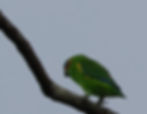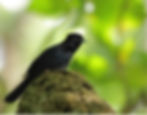Warrina Lakes and Botanical Gardens bird survey: February 2025
- Guest Contributor
- Mar 12
- 3 min read
Updated: Jun 23
Geoff Stapley | Guest Contributor
With the date Sunday, 9 February approaching, everyone was thinking "Will the bird survey be achievable?". The Warrina Lakes area, along with a lot of North Queensland, had been experiencing the Wet Season and it wasn’t letting up, with forecasts of tropical lows, possible cyclones, heavy rain, and local flooding. The flooding became quite extensive in various areas, including of course our study area at Warrina Lakes.
The prognosis wasn’t looking good, but our trusty Cassowary Coast Area Coordinator emailed us to advise that Warrina had missed the worst and a survey was possible.
Thus on Sunday morning a group of four hardy souls arrived at the Warrina Lakes carpark which wasn’t under water and the sky had only patchy clouds, all good signs. We were prepared though with umbrellas, rain jackets, and gumboots.
When we walked to the southern drain, sharp ears heard a flycatcher, but it was only a quick sighting then the bird was off, and so was the team. After a couple more brief sightings we decided it was a Shining Flycatcher: alas, no images. Back on track we walked past the domestic ‘guardian geese’ and native Bush Stone-curlews. Australasian Figbirds and Pied Imperial-Pigeons were above us, but not providing opportunities for photographers. Then there was a shower of rain. A Forest Kingfisher perched on the rail beside the train shed.
Not to be deterred we crossed the northern channel past the lake. Two juvenile Comb-crested Jacanas were seen, and we were later to see two adults.
We crossed the footbridge and all was quiet, then as we turned the corner a host of juvenile Metallic Starlings and Australasian Figbirds flew in and around, so hard to count. Further on, our pathway was flooded, so two of our team turned back and two soldiered on. Their gumboots helped.

Royal Spoonbill, Orange-footed Megapode, and Large-billed Gerygone were seen. Despite overcast conditions and water under foot, sharp eyes weren’t disappointed.
Then high up with a host of Australasian Figbird adults and juveniles, perched a lone Double-eyed Fig-Parrot (the little green blob on the upper part of the lower left-hand branch). My heavily cropped image (below) shows we weren’t mistaken. Being our smallest parrot it’s a real challenge for a photographer.



Back at the northern channel, the water level was up with the tide coming in and the freshwater backing up. We saw an Eastern Great Egret on our way to morning tea.

Back on the main lake our two adult Jacanas were sighted. No White-browed Crake or ducks were seen. A Little Black Cormorant and Australian [White] Ibis flew by. My goodness – a burst of sunshine!

In the fig grove more Shining Flycatchers were seen: active adults and juveniles. I managed an image but the light wasn’t ideal despite increasing the ISO.

For a full list of today’s birds please use this Link to see it in eBird - numbers were down, but this was not unexpected due to the recent weather the area had been experiencing.
Warrina Lakes is listed as having 130 species of recorded birds but I haven’t been able to track down a comprehensive list. If you know of one I would like to get a copy.
Failing that I have decided to start a Warrina Lakes Bird List starting with the earlier, original records, and adding any new records that we see each month. Hopefully by year’s end we will have a more comprehensive list, but it may be not 130 species of course. We will be trying for images.

